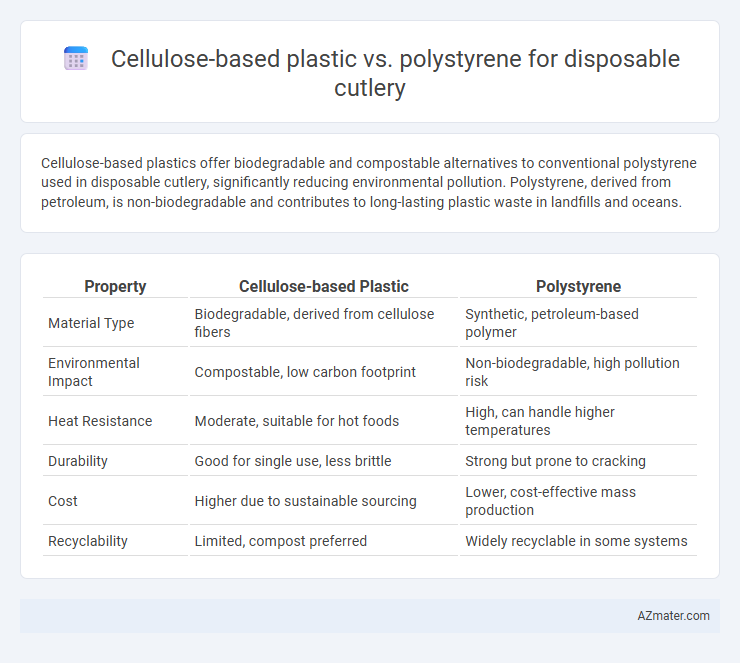Cellulose-based plastics offer biodegradable and compostable alternatives to conventional polystyrene used in disposable cutlery, significantly reducing environmental pollution. Polystyrene, derived from petroleum, is non-biodegradable and contributes to long-lasting plastic waste in landfills and oceans.
Table of Comparison
| Property | Cellulose-based Plastic | Polystyrene |
|---|---|---|
| Material Type | Biodegradable, derived from cellulose fibers | Synthetic, petroleum-based polymer |
| Environmental Impact | Compostable, low carbon footprint | Non-biodegradable, high pollution risk |
| Heat Resistance | Moderate, suitable for hot foods | High, can handle higher temperatures |
| Durability | Good for single use, less brittle | Strong but prone to cracking |
| Cost | Higher due to sustainable sourcing | Lower, cost-effective mass production |
| Recyclability | Limited, compost preferred | Widely recyclable in some systems |
Introduction to Disposable Cutlery Materials
Disposable cutlery materials primarily include cellulose-based plastic and polystyrene, each with distinct environmental and performance characteristics. Cellulose-based plastics are derived from renewable plant fibers, offering biodegradability and reduced carbon footprint compared to conventional petroleum-based polystyrene, which is known for its rigidity, low cost, and ease of manufacturing. The choice between these materials impacts sustainability goals, as cellulose-based options contribute to waste reduction, while polystyrene remains prevalent due to extensive industrial infrastructure and lower initial costs.
What is Cellulose-Based Plastic?
Cellulose-based plastic is a biodegradable material derived from cellulose, a natural polymer found in plant cell walls, primarily sourced from wood pulp or cotton fibers. Unlike polystyrene, which is petroleum-based and non-biodegradable, cellulose-based plastics break down more efficiently in composting environments, reducing environmental impact significantly. This sustainable alternative offers comparable durability and heat resistance suitable for disposable cutlery, promoting eco-friendly single-use products.
Overview of Polystyrene Cutlery
Polystyrene cutlery, made from synthetic aromatic polymer styrene, is widely used for disposable utensils due to its lightweight, rigidity, and low manufacturing cost. Its thermoplastic properties allow easy molding into various shapes, but it is non-biodegradable, contributing significantly to plastic pollution. Compared to cellulose-based alternatives, polystyrene offers superior durability but lacks environmental sustainability, making it a controversial choice in eco-conscious markets.
Environmental Impact: Cellulose vs. Polystyrene
Cellulose-based plastic disposable cutlery offers significant environmental benefits due to its biodegradability and compostability, breaking down naturally within months under industrial composting conditions. In contrast, polystyrene cutlery, derived from non-renewable petroleum resources, persists in the environment for centuries, contributing to plastic pollution and harming marine life. The carbon footprint of cellulose-based plastics is substantially lower, as they are often produced from renewable plant fibers, reducing greenhouse gas emissions compared to the fossil fuel-intensive production of polystyrene.
Biodegradability and Compostability Comparison
Cellulose-based plastic disposable cutlery demonstrates superior biodegradability and compostability compared to polystyrene, breaking down naturally within months under industrial composting conditions. Polystyrene, a petroleum-derived polymer, is resistant to degradation and can persist in the environment for hundreds of years, contributing to plastic pollution and landfill accumulation. Cellulose's plant-based composition enables it to decompose into non-toxic organic matter, supporting sustainable waste management and reducing ecological impact.
Performance and Durability in Food Use
Cellulose-based plastics offer superior biodegradability and resistance to heat and oil, making them ideal for disposable cutlery in hot and greasy food applications. Polystyrene is lightweight and inexpensive but tends to become brittle and can leach chemicals when exposed to heat, compromising durability and safety. The performance of cellulose-based cutlery in maintaining structural integrity under heat and moisture surpasses polystyrene, ensuring safer and more reliable use in food service.
Cost Analysis: Production and Consumer Pricing
Cellulose-based plastic cutlery typically incurs higher production costs due to the raw material processing and specialized manufacturing techniques required, compared to polystyrene, which benefits from lower material and production expenses. Consumer pricing for cellulose-based cutlery reflects these elevated costs, often resulting in more expensive retail prices that can challenge market competitiveness. Polystyrene's established supply chain and economies of scale contribute to its affordability, making it a cost-effective option for disposable cutlery despite environmental concerns.
Regulatory and Certification Trends
Cellulose-based plastics for disposable cutlery are gaining traction due to their compliance with stringent biodegradability standards such as ASTM D6868 and EN 13432, reflecting a global regulatory shift toward sustainable materials. Polystyrene cutlery faces increasing restrictions under single-use plastic bans in the EU, India, and several US states, driven by environmental concerns and circular economy policies. Certification trends highlight a growing preference for compostability labels and bio-based content verification, positioning cellulose-based products as favorable alternatives in regulatory frameworks worldwide.
Consumer Perception and Market Demand
Cellulose-based plastic disposable cutlery is perceived by consumers as an eco-friendly alternative, aligning with growing demand for sustainable products and reducing plastic waste. Polystyrene cutlery, while economically cheaper and widely available, faces increasing consumer resistance due to environmental concerns and stricter regulations. Market trends show a significant shift towards biodegradable materials, with cellulose-based plastics experiencing higher growth rates driven by environmentally conscious buyers.
Future Prospects for Sustainable Cutlery Solutions
Cellulose-based plastic offers promising future prospects for sustainable disposable cutlery due to its biodegradability and renewable resource base, reducing environmental impact compared to traditional polystyrene. Polystyrene, while cost-effective and durable, faces increasing regulatory restrictions and environmental concerns due to its non-biodegradable nature and pollution contribution. Innovations in cellulose-based material processing and scalability are poised to drive widespread adoption, aligning with global sustainability goals and circular economy initiatives.

Infographic: Cellulose-based plastic vs Polystyrene for Disposable cutlery
 azmater.com
azmater.com